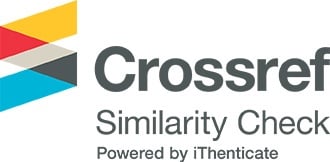PHỤC HÌNH ENDOCROWN TRÊN RĂNG CỐI NHỎ ĐÃ NỘI NHA: BÁO CÁO MỘT CA LÂM SÀNG
Các tác giả
DOI: https://doi.org/10.59294/HIUJS.KHTT.2024.028Từ khóa:
Endocrown, phục hình dánTóm tắt
Đặt vấn đề: Điều trị nội nha là một thủ thuật phổ biến trong hoạt động chuyên môn hằng ngày của các bác sĩ Răng Hàm Mặt. Theo Ray và cộng sự, một phục hồi tốt có tác động lâu dài hơn đối với răng đã điều trị tuỷ so với chính điều trị tuỷ đó. Do đó, việc lựa chọn phục hồi cho các răng đã điều trị nội nha vẫn còn là một vấn đề được các bác sĩ quan tâm, đặc biệt là đối với nhóm răng cối nhỏ, tham gia vào hướng dẫn sang bên. Mục tiêu nghiên cứu: Đánh giá kết quả điều trị phục hồi răng cối nhỏ hàm dưới đã nội nha bằng phục hình endocrown. Phương pháp nghiên cứu: Báo cáo ca lâm sàng với một trường hợp bệnh nhân nữ, 38 tuổi đến khám và có nhu cầu điều trị phục hồi răng cối nhỏ hàm dưới đã nội nha. Kết quả: Tất cả các tiêu chí đều được xếp loại A theo tiêu chí đánh giá của Cơ quan Dịch vụ sức khoẻ công cộng Hoa Kỳ (USPHS) và bệnh nhân cũng đánh giá rất hài lòng (mức 5) về phục hình này. Kết luận: Endocrown là một kiểu thiết kế phục hình bảo tồn mô răng tối đa phù hợp đối với răng cối nhỏ đã nội nha.
Abstract
Background: Endodontic treatment is a common procedure in the daily professional practice of dentists. According to Ray et al., a good restoration has a more lasting impact on a root canal treated tooth than the root canal treatment itself. Therefore, the choice of restoration for endodontically treated teeth remains an issue of concern for physicians, especially for the premolar group, involved in lateral guidance. Objectives: Evaluate the results of restorative treatment of a endodontically treated mandibular premolar with endocrown restorations. Method: Clinical case report of a 38-year-old female patient who came for examination and needed treatment to restore an endodontic lower molar. Results: All criteria were graded A according to the evaluation criteria of the United States Public Health Service (USPHS) and the patient also rated this restoration as very satisfied (level 5). Conclusion: Endocrown is a type of restoration design that preserves maximum tooth tissue and is suitable for endodontically treated premolars.
Tài liệu tham khảo
[1] Carvalho MAD, Lazari PC, Gresnigt M, Del Bel Cury AA & Magne P., “Current options concerning the endodontically-treated teeth restoration with the adhesive approach”, Braz Oral Res, 32(Supp.1), e74, 2018.
DOI: https://doi.org/10.1590/1807-3107bor-2018.vol32.0074[2] Elalem IA, Ibraheem RM & Hamdy AM., “Clinical evaluation of the marginal integrity, and internal fit of E-Max endocrown restorations with different marginal preparation designs, Ex-vivo study,” J Dent Oral Health, 5(1), 128, 2019.
[3] Bindl A & Mörmann WH., “Clinical evaluation of adhesively placed Cerec endo-crowns after 2 years–preliminary results”, J Adhes Dent 1255-265, 1999.
[4] Bernhart J., Bräuning A., Altenburger M.J. & Wrbas K.T. (2010), “Cerec 3D endocrowns two year clinical examination of CAD/CAM crowns for restoring endodontically treated molars”, Int J Comput Dent, 13(1), 141-154, 2010.
[5] Dejak B & Mlotkowski A., “3D-Finite element analysis of molars restored with endocrowns and posts during masticatory simulation”, Dent Mater, 29 (12), e309-317, 2013.
DOI: https://doi.org/10.1016/j.dental.2013.09.014[6] Ziting Zheng at al., “Influence of margin design and restorative material on the stress distribution of endocrowns: a 3D finite element analysis”, BMC Oral Health, 22(30)”, Journal of Interdisciplinary Dental Sciences, 9(1), 07-12 (66), 2022.
[7] Govare N. & Contrepois M., “Endocrowns: A systematic review”, J Prosthet Dent, 123(3), 411-418, 2020.
DOI: https://doi.org/10.1016/j.prosdent.2019.04.009[8] Pissis P., “Fabrication of a metal‐free ceramic restoration utilizing the monobloc technique”, Pract Periodontics Aesthet Dent, 7, 83‐94, 1995.
[9] Fages M. and Bertrand Bennasar, “The Endocrown: A Different Type of All-Ceramic Reconstruction for Molars”, Canadian Dental Association, 79 (1), d140, 2013.
[10] Ziting Zheng at al., “Influence of margin design and restorative material on the stress distribution of endocrowns: a 3D finite element analysis”, Journal of Interdisciplinary Dental Sciences, 9(1), 07-12, 2022.
DOI: https://doi.org/10.1186/s12903-022-02063-y[11] John F. Cvar & Gunnar Ryge, “Reprint of Criteria for the clinical evaluation of dental restorative materials”, Clin Oral Invest, 9 (1), 215-232, 2005.
DOI: https://doi.org/10.1007/s00784-005-0018-z[12] Tzimas K, Tsiafitsa M, Gerasimou P, et al., “Endocrown restorations for extensively damaged posterior teeth: clinical performance of three cases”, Restor Dent Endod, 43(4), e38, 2018.
DOI: https://doi.org/10.5395/rde.2018.43.e38[13] Belleflamme MM, Geerts SO, Louwette MM & Vanheusden AJ Grenade CF, Mainjot AK., “No post-no core approach to restore severely damaged posterior teeth: An up to 10-year retrospective study of documented endocrown cases”, J Dent, 63, 1-7, 2017.
DOI: https://doi.org/10.1016/j.jdent.2017.04.009Tải xuống
Tải xuống: 230











